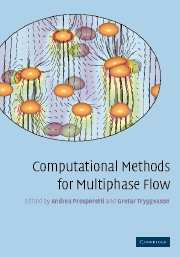Book contents
- Frontmatter
- Contents
- Preface
- Acknowledgments
- 1 Introduction: A computational approach to multiphase flow
- 2 Direct numerical simulations of finite Reynolds number flows
- 3 Immersed boundary methods for fluid interfaces
- 4 Structured grid methods for solid particles
- 5 Finite element methods for particulate flows
- 6 Lattice Boltzmann models for multiphase flows
- 7 Boundary integral methods for Stokes flows
- 8 Averaged equations for multiphase flow
- 9 Point-particle methods for disperse flows
- 10 Segregated methods for two-fluid models
- 11 Coupled methods for multifluid models
- References
- Index
1 - Introduction: A computational approach to multiphase flow
Published online by Cambridge University Press: 07 December 2009
- Frontmatter
- Contents
- Preface
- Acknowledgments
- 1 Introduction: A computational approach to multiphase flow
- 2 Direct numerical simulations of finite Reynolds number flows
- 3 Immersed boundary methods for fluid interfaces
- 4 Structured grid methods for solid particles
- 5 Finite element methods for particulate flows
- 6 Lattice Boltzmann models for multiphase flows
- 7 Boundary integral methods for Stokes flows
- 8 Averaged equations for multiphase flow
- 9 Point-particle methods for disperse flows
- 10 Segregated methods for two-fluid models
- 11 Coupled methods for multifluid models
- References
- Index
Summary
This book deals with multiphase flows, i.e. systems in which different fluid phases, or fluid and solid phases, are simultaneously present. The fluids may be different phases of the same substance, such as a liquid and its vapor, or different substances, such as a liquid and a permanent gas, or two liquids. In fluid-solid systems, the fluid may be a gas or a liquid, or gases, liquids, and solids may all coexist in the flow domain.
Without further specification, nearly all of fluid mechanics would be included in the previous paragraph. For example, a fluid flowing in a duct would be an instance of a fluid-solid system. The age-old problem of the fluid-dynamic force on a body (e.g. a leaf in the wind) would be another such instance, while the action of wind on ocean waves would be a situation involving a gas and a liquid.
In the sense in which the term is normally understood, however, multiphase flow denotes a subset of this very large class of problems. A precise definition is difficult to formulate as, often, whether a certain situation should be considered as a multiphase flow problem depends more on the point of view – or even the motivation – of the investigator than on its intrinsic nature. For example, wind waves would not fall under the purview of multiphase flow, even though some of the physical processes responsible for their behavior may be quite similar to those affecting gas–liquid stratified flows, e.g. in a pipe – a prime example of a multiphase system. The wall of a duct or a tree leaf may be considered as boundaries of the flow domain of interest, which would not qualify these as multiphase flow problems.
- Type
- Chapter
- Information
- Computational Methods for Multiphase Flow , pp. 1 - 18Publisher: Cambridge University PressPrint publication year: 2007
- 2
- Cited by



